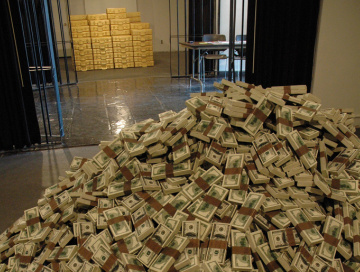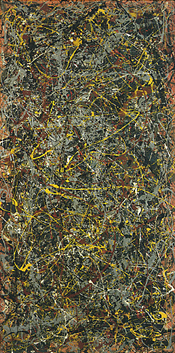
Srdjan Loncar, "Value" (2008), as exhibited at the Old U.S. Mint during Prospect.1 New Orleans
Money is on everyone’s mind but particularly for those in the art world, which faces one of the most difficult economic climates in ages. The last few months on this blog we’ve posted about art and economics, looking at them from various angles and reflecting on a topic to which there is never a conclusion. Here are some highlights from this newly concluded Flash Points topic, “What is the Value of Art?”
Beth Allen kicked off the discussion:
Buried within questions about the economics of art are assumptions, and often judgments, about its value that beg to be examined: How is the value of an artist’s intellectual versus physical labor calculated? Are collectible works valued differently than ephemeral projects?
Ben Street highlighted parallels between the world of money and art:
[they]…may not be equivalent, but they are remarkably alike. As Swiss artist Daniel Spoerri put it, “in exchanging art for money, we exchange one abstraction for another.”
Thomas Micchelli offered his own insights:
Money may be a shared commodity but it fractures perception; not only is it the most unreliable historical indicator of aesthetic value, but when art is rendered into a trophy and displayed as such, its role as a piece of communal experience, owned by all, is diminished.
Lila Kanner pointed out that the artist’s role is crucial in our understanding of art economics and that “currency in art has a beautiful double meaning – it’s about cultural relevance as well as economics.”

Jackson Pollock's "No.5, 1948" (1948) is, according to Wikipedia, the
most expensive painting in history.
Then there were the tales of financial woe, from the impact that the economic downturn has had on museums (more) to artists looking to be fairly compensated for their work in museums.
Some bloggers looked at artists who thrive in the capitalist system, others sought out alternative economies, including one Chicago-based research institute (InCUBATE) that critically examines models for arts funding, and the Exhibition & Free Store in New York, which sought to “demonstrate the value of free art, free imagination, free form, and free rewards.”
The role of the arts administrator was raised by Tracy Candido, who reminded us, “I am an arts administrator, which is arguably the second invisible position in line behind the artist” and Richard McCoy wrote about the question of value from an art conservator’s point of view.
Julia Steinmetz took a different approach to the question of art’s value and cast her net into the body of Adrian Piper’s work to suggest that “art’s value is its capacity to direct our attention to a particular object, image, sound, environment, or situation.”
Among the key posts of the last few months, there were numerous interviews that focused on economics in different ways, including:
- a video chat with Jackie Battenfield, whose first book The Artist’s Guide: How to Make a Living Doing What You Love is a practical reference book that she wished she had when she began her own art career;
- a Q&A with David A. Ross, former director of the Whitney and SFMOMA, who offers his opinion on art’s economic future;
- Arnold Lehman, director of the Brooklyn Museum, spoke about the financial strain on major institutions;
- Dublin-based artist Seoidín O’Sullivan, explained her interest in helping communities feel empowered and take “ownership and responsibility in and for their localities”;
- Bjøernstjerne Christiansen of SUPERFLEX, who addressed the Danish trio’s critique of (doomed) economic systems; and
- and New York $treet Artist$ Enjoy Banking, who plastered the city with fanciful economic messages like “Enjoy Stimulus Package.”
Finally, we looked at the state of federal arts funding by the numbers and then spoke to the House Arts Caucus co-chairs about the state of federal funds for the arts.
For future reading and some hot topics in the news related to Art+Economics, try these:
- LA Times art critic Christopher Knight explores the merry-go-round of museums that deaccession art to buy more art and then change their minds about what they should be buying;
- Felix Salmon, writing for The Atlantic, thinks that if the federal government is serious about stimulating the economy, it should give out some money to its poorest citizens, artists, since “Arts spending is fantastic at creating employment: for every $30,000 or so spent on the arts, one more person gets a job, compared with about $1 million if you’re building a road or hospital”;
- the US House increased arts and humanities funding, including an additional 9.7% or $15 million increase from this year’s budget for the National Endowment for the Arts (NEA);
- New York gallerist and blogger Ed Winkleman has written a brand new book How to Start and Run a Commercial Art Gallery—it goes on sale tomorrow (Tues., July 14)–which promises to be a comprehensive guide for those eager to start their own gallery; and
- a Boston-based artist Geoff Hargadon has created, CASH FOR YOUR WARHOL website, for those who want to dispose of their Warhols quickly. He explained to Artinfo that he has received mixed reactions: “I have received a lot of calls, most of them hang-ups (curiosity?), but a few have probably been real. I haven’t returned the calls yet cause I don’t know what to say to them quite yet. Would I buy a Warhol from them? Sure, but I haven’t figured out the pricing thing.”



